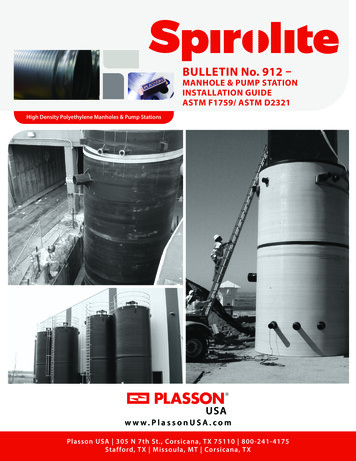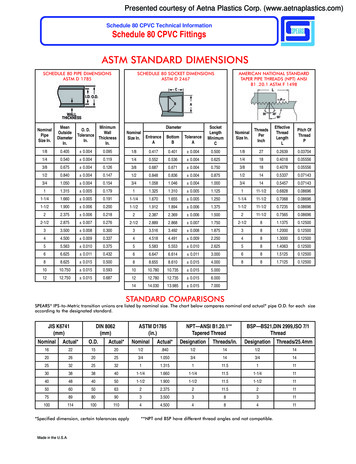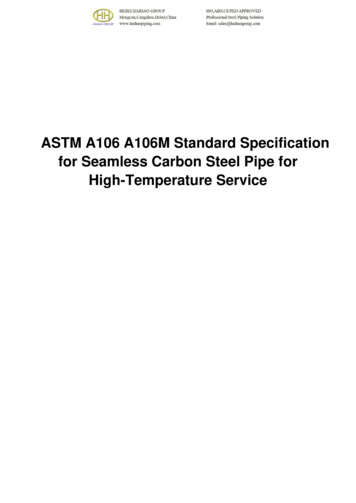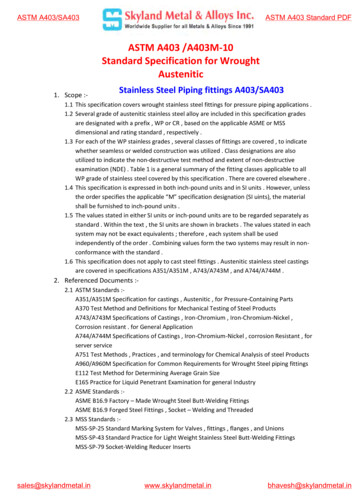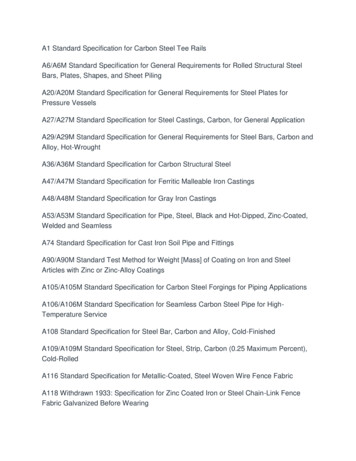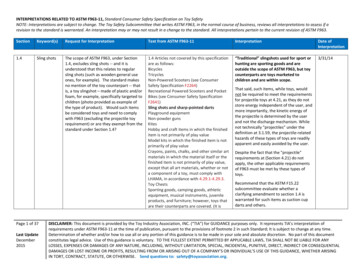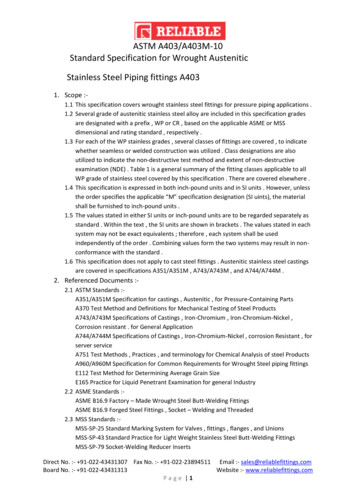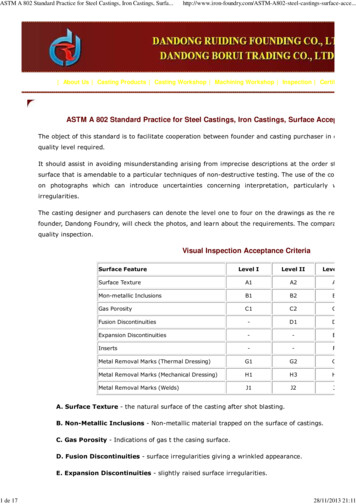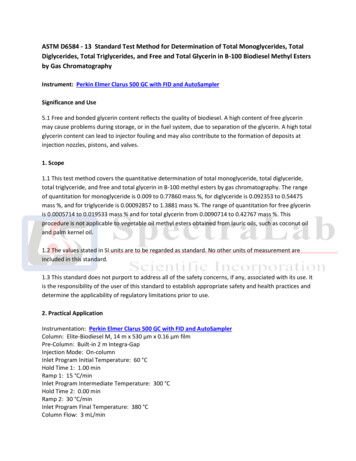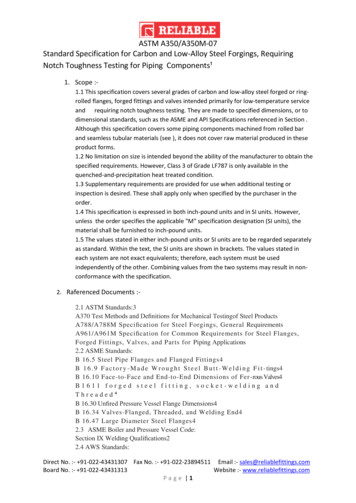
Transcription
ASTM A350/A350M-07Standard Specification for Carbon and Low-Alloy Steel Forgings, RequiringNotch Toughness Testing for Piping Components¹1. Scope :1.1 This specification covers several grades of carbon and low-alloy steel forged or ringrolled flanges, forged fittings and valves intended primarily for low-temperature serviceand requiring notch toughness testing. They are made to specified dimensions, or todimensional standards, such as the ASME and API Specifications referenced in Section .Although this specification covers some piping components machined from rolled barand seamless tubular materials (see ), it does not cover raw material produced in theseproduct forms.1.2 No limitation on size is intended beyond the ability of the manufacturer to obtain thespecified requirements. However, Class 3 of Grade LF787 is only available in thequenched-and-precipitation heat treated condition.1.3 Supplementary requirements are provided for use when additional testing orinspection is desired. These shall apply only when specified by the purchaser in theorder.1.4 This specification is expressed in both inch-pound units and in SI units. However,unless the order specifies the applicable "M" specification designation (SI units), thematerial shall be furnished to inch-pound units.1.5 The values stated in either inch-pound units or SI units are to be regarded separatelyas standard. Within the text, the SI units are shown in brackets. The values stated ineach system are not exact equivalents; therefore, each system must be usedindependently of the other. Combining values from the two systems may result in nonconformance with the specification.2. Raferenced Documents :2.1 ASTM Standards:3A370 Test Methods and Definitions for Mechanical Testingof Steel ProductsA788/A788M Specification for Steel Forgings, General RequirementsA961/A961M Specification for Common Requirements for Steel Flanges,Forged Fittings, Valves, and Parts for Piping Applications2.2 ASME Standards:B 16.5 Steel Pipe Flanges and Flanged Fittings4B 1 6 . 9 F a c t o r y - M a d e W r o u g h t S t e e l B u t t - W e l d i n g F i t - tings4B 16.10 Face-to-Face and End-to-End Dimensions of Fer -rous Valves4B1611 forged steel fitting, socket-welding andThreaded⁴B 16.30 Unfired Pressure Vessel Flange Dimensions4B 16.34 Valves-Flanged, Threaded, and Welding End4B 16.47 Large Diameter Steel Flanges42.3 ASME Boiler and Pressure Vessel Code:Section IX Welding Qualifications22.4 AWS Standards:Direct No. :- 91-022-43431307 Fax No. :- 91-022-23894511 Email :- sales@reliablefittings.comBoard No. :- 91-022-43431313Website :- www.reliablefittings.comPage 1
ASTM A350/A350M-07A 5.1 Mild Steel Covered Arc-Welding Electrodes5A 5.5 Low-Alloy Steel Covered Arc-Welding Electrodes52.5 API Standards:6600 Steel Gate Valves with Flanged or Butt-Welding Ends602 Compact Design Carbon Steel Gate Valves for Refinery Use605 :Large Diameter Carbon Steel Flanges3. Ordering Information :3.1 It is the purchaser’s responsibility to specify in the purchase order informationnecessary the needed material. In addition to the ordering information guidelines inSpecification A961/A961M, orders should include the following information:3.1.1 The number of test reports required (see Section 14).3.1.2 Additional requirements (see Table 1 Footnotes).4. General Requirements :4.1 Product furnished to this specification shall conform to the requirements ofspecification A961/A961M, including any supplementary requirements that areindicated in the purchase order. Failure to comply with the general requirements ofspecification A961/A961M constitutes non-conformance with this specification. Incase of conflict between the requirements of this specification and SpecificationA961/A961M, this specification shall prevail.5. Manufacture :5.1 Melting Process — The steel shall be produced by any of the following primaryprocesses; open-hearth, basic-oxygen, electric-furnace, or vacuum-induction melting(VIM). The primary melting may incorporate separate degassing or refining, and maybe followed by secondary melting using electroslag remelting (ESR), or vacuum-arcremelting (VAR).5.1.1 The steel shall be fully killed, fine-grain practice.5.1.2 The molten steel may be vacuum treated prior to or during pouring of theingot.5.2 Discard — A sufficient discard shall be made to secure freedom from injurious pipingand undue segregation.5.3 Forging Process:5.3.1 Material for forgings shall consist of ingots, or forged, rolled, or strandcastblooms, billets, slabs, or bars.5.3.2 The finished product shall be a forging as defined in the Terminology section ofSpecification A 788/A788M.5.3.3. Except for flanges of all types, hollow, cylindrically-shaped parts may bemachined from rolled bar or seamless tubular materials provided that the axial lengthof the part is approximately parallel to the metal flow lines of the stock. Other parts,excluding flanges of all types, may be machined from hot-rolled or forged bar upthrough and including NPS 4. Elbows, return bends, tees, and header tees shall not bemachined directly from bar stock.5.4 Heat Treatment:5.4.1 After hot working and before reheating for heat treatment, the forging shall beallowed to cool substantially below the transformation range.Direct No. :- 91-022-43431307 Fax No. :- 91-022-23894511 Email :- sales@reliablefittings.comBoard No. :- 91-022-43431313Website :- www.reliablefittings.comPage 2
ASTM A350/A350M-075.4.2 Forgings of grades other than Grade LF787 shall be furnished in thenormalized, or in the normalized and tempered, or in the quenched and temperedcondition described by the following procedures:5.4.2.1 Normalize — Heat to a temperature that produces an austenitic structure,holding sufficient time to attain uniform temperature throughout. Cool uniformly instill air.5.4.2.2Normalize and Temper — Subsequent to normalize, reheat to 1100 F [590 C] minimum, holding at temperature a minimum of 30 min/in. [30 min/25 mm] ofmaximum thickness, but in no case less than 30 min. Cool in still air.5.4.2.3 Quench and Temper — The procedure for quenching shall consist of either(1)fully austenitizing the forgings followed by quenching in a suitableliquid medium or (2) using a multiple stage procedure whereby the forging is firstfully austenitized and rapidly cooled, then reheated to partiall reaustenitize, followedby quenching in a suitable liquid medium. All quenched forgings shall be temperedby reheating to a temperature between 1100 F [590 C] and the lower transformationtemperature, holding a temperature a minimum of 30 min/in. [30 min/25 mm] ofmaximum thickness but in no case less than 30 min. Cool in still air.5.4.3 Grade LF787 forgings shall be furnished in either the normalized-andprecipitation, heat-treated condition or in the quenched-and-precipitation, heattreatedcondition. The heat treatment procedures shall be as follows:5.4.3.1 Normalized-and-Precipitation Heat Treated — Heat to a temperature in therange from 1600 to 1725 F [870 to 940 C], hold at the temperature for a timesufficient to attain uniform temperature throughout, soak at the temperature for notless than 1 2 hr, and remove from the furnace and cool in air. Subsequently, heat to atemperature in the range from 1000 to 1200 F [540 to 650 C], soak at thetemperature for not less than 1 2 hr, and cool at any convenient rate.5.4.3.2 Quenched-and-Precipitation Heat Treated — Heat to a temperature in therange from 1600 to 1725 F [879 to 940 C], hold at the temperature for a timesufficient to attain uniform temperature throughout, soak at the temperature for notless than 1 2 hr and quench in a suitable liquid medium byimmersion; reheat to a temperature in the range from 1000 to 1225 F [540 to 665 C],hold at the temperature for not less than 1 2 hr, and cool at any convenient rate.ElementTABLE 1 Chemical RequirementsComposition, %Grade LF1 Grade LF2 Grade LF3Grade LF5Grade LF6Grade LF9GradeLF787Carbon, .60-1.350.90 max0.60-1.351.15-1.500.40-1.060.40-0.70Phosphorus, max0.0350.0350.0350.0350.0250.0350.025Sulfur, 15-0.300.15-0.300.20-0.350.20-0.350.15-0.30.0.40 maxNickel0.40 maxᴮ0.40 maxᴮ3.3-3.71.0-2.00.40 maxᴮ1.60-2.240.70-1.00Chromium0.30 maxᵇ ᶜ 0.30 maxᵇ ᶜ 0.30 maxᶜ0.30 maxᶜ0.30 maxᵇ ᶜ 0.30 maxᶜ0.60-0.90Molybdenum0.12 maxᵇ ᶜ 0.12 maxᵇ ᶜ 0.12 maxᶜ0.12 maxᶜ0.12 maxᵇ ᶜ 0.12 maxᶜ0.15-0.25Copper0.40 maxᴮ0.40 maxᴮ0.40 max0.40 max0.40 maxᴮ0.75-1.251.00-1.30Direct No. :- 91-022-43431307 Fax No. :- 91-022-23894511 Email :- sales@reliablefittings.comBoard No. :- 91-022-43431313Website :- www.reliablefittings.comPage 3
ASTM A350/A350M-07ColumbiumVanadiumNitrogen0.02 maxᴰ0.08 max.0.02 maxᴰ0.08 max.0.02 max0.03 max.0.02 max0.03 max.0.02 max0.04-0.110.01-0.0300.02 max0.03 max.0.02 min0.03 max.6. Chemical Composition :6.1 Heat Analysis:6.1.1. An analysis of each heat of steel shall be made by the steel producer fromsamples taken preferably during the pouring of the heat. The results shallconform to Table 1. Leaded steel shall not be permitted.6.2 Product Analysis:6.2.1 The purchaser may make a product analysis on products supplied to thisspecification in accordance with specification A961/A961M.7. Mechanical Properties :7.1 Tension Tests:7.1.1 Requirements — The material shall conform to requirements for tensile propertiesin Table 2.7.1.1.1 The test specimen shall be obtained from a rough or finished production forging,or prolongation thereof, or it may be obtained from separately forged test blanks from thesame heat of steel as the production forging. The test blank shall be reduced by forging ina manner similar to that for the products represented, and shall receive approximately thesame hot working and reduction and the same heat treatment as the finished productsrepresented. The test material shall be treated in the same furnace at the same time as theforging it represents, subject to the requirements of 7.1.2.1.7.1.1.2 The test specimen shall represent all forgings from the same heat and heattreatment load whose maximum thicknesses do not exceed the thickness of the testforging or blank by more than 1 4 in. [6 mm].7.1.2 Number of Tests — One tension test at room temperature shall be made inaccordance with 6.1.1.2 from each heat in each heat-treatment load.7.1.2.1 If heat treatment is performed in either a continuous or a batch-type furnacecontrolled with 625 F [614 C] of the required heat-treatment temperature and equippedwith recording pyrometers so that complete records of heat treatment are available and ifthe same heat-treating cycles are used on the forgings represented by the tension test, thenone tension test from each heat shall be required, instead of one tension test from eachheat in each heat treatment load in accordance with 7.1.1.2.7.1.3 Test Locations and Orientations — The test specimen shall be removed from theheaviest section of the forging or test blank, at locations described in6.1.3.1, 6.1.3.2, 6.1.3.3, or as close to these locations as practical, subject to forging sizeand geometry.7.1.3.1 For forgings or test blanks having a maximum heat-treated thickness, T, of 2 in.[50 mm] or less, the longitudinal axis of the test specimen shall be taken at mid-thicknessand its mid-length shall be at least 2 in. [50 mm] from a second heat-treated surface,exclusive of the T dimension surfaces. (This is normally referred to as 1 2 T by 2 in. [50mm]).7.1.3.2 For forgings or test blanks having a maximum heat-treated thickness, T, greaterthan 2 in. [50 mm], the central axis of the test specimen shall be taken at least 1 4 T fromthe nearest heat-treated surface and at least T or 4 in. [100 mm], whichever is less, fromDirect No. :- 91-022-43431307 Fax No. :- 91-022-23894511 Email :- sales@reliablefittings.comBoard No. :- 91-022-43431313Website :- www.reliablefittings.comPage 4
ASTM A350/A350M-07any second heat-treated surface. See Fig. 2 for test specimen location in separately forgedtest blanks for quenched and tempered forgings.7.1.3.3 Metal Buffers – The required distances from hear treated surfaces may beobtained with metal buffers instead of integral expansions. Buffer material may be carbonor low alloy steel, and shall be joined to the forging with a partial penetration weld thatseals the buffered surface. Specimens shall be located at ½ in. [13 mm] minimum fromthe buffered surface of the forging. Buffers shall be removed and the welded areassubjected to magnetic particle test to assure freedom from cracks unless the welded areasare completely removed by subsequent machining.7.1.3.4 The test specimen shall have its longitudinal axis located parallel to the directionof major working of the forging or test blank.7.1.3.5 With prior purchaser approval, tests may be taken at a depth (t) corresponding tothe distance from the area of significant loading to the nearest heat treated surface and atleast twice this distance (2t) from any second surface. However, the test depth shall not benearer to one treated surface than 3 4 in.[19 mm] and to the second treated surface than 11 2 in. [38 mm]. This method of testlocation would normally apply to contour-forged parts, or parts with thick cross sectionalareas where 1 4 T T testing (7.1.3.2) is not practical. Sketches showing the exact testlocations shall be approved by the purchaser when this method is used.7.1.4 Test Method — Testing shall be performed in accordance with Test Methods andDefinitions A370. The test specimen shall be as large as is practicable and shall bemachined to the form and dimensions of Fig. 7 of Test Methods and Definitions A 370.When seamless tubular materials are used, testing shall be performed on longitudinalspecimens in accordance with Annex A2, Steel Tubular Products, of Test Methods andDefinitions A370.7.2 Impact test:7.2.1 Requirements — The material shall conform to the requirements for impactproperties in Table 3 when tested at the applicable standard
ASTM A350/A350M-07 Direct No. :- 91-022-43431307 Fax No. :- 91-022-23894511 Email :- sales@reliablefittings.com Board No. :- 91-022-43431313 Website :- www.reliablefittings.com P a g e 1 Standard Specification for Carbon and Low-Alloy Steel Forgings, Requiring Notch Toughness Testing for Piping Components¹ 1. Scope :- 1.1 This specification covers several grades of carbon and low-alloy .


